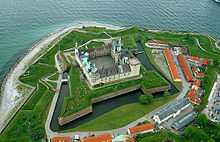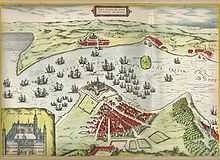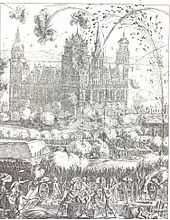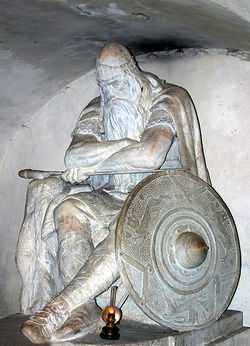Kronborg
| Kronborg Castle | |
|---|---|
| Name as inscribed on the World Heritage List | |
 | |
| Type | Cultural |
| Criteria | iv |
| Reference | 696 |
| UNESCO region | Europe and North America |
| Inscription history | |
| Inscription | 2000 (24th Session) |
Kronborg is a castle and Stronghold in the town of Helsingør, Denmark. Immortalized as Elsinore in William Shakespeare's play Hamlet, Kronborg is one of the most important Renaissance castles in Northern Europe and has been added to UNESCO's World Heritage Sites list (2000).[1]
The castle is situated on the extreme northeastern tip of the island of Zealand at the narrowest point of the Øresund, the sound between Denmark and Sweden. In this part, the sound is only 4 km wide, hence the strategic importance of maintaining a coastal fortification at this location commanding one of the few outlets of the Baltic Sea.
The castle's story dates back to a stronghold, Krogen, built by King Eric VII in the 1420s. Along with the fortress Kärnan, Helsingborg on the opposite coast of Øresund, it controlled the entranceway to the Baltic Sea. From 1574 to 1585 King Frederick II had the medieval fortress radically transformed into a magnificent Renaissance castle. The main architects were the Flemings Hans Hendrik van Paesschen and Anthonis van Obbergen, whereas the sculptural work was coordinated by Gert van Groningen. In 1629 a fire destroyed much of the castle, but King Christian IV subsequently had it rebuilt. The castle also has a church within its walls. In 1658 Kronborg was besieged and captured by the Swedes who took many of its valuable art treasures as war booty. In 1785 the castle ceased to be a royal residence and was converted into barracks for the army. The army left the castle in 1923, and after a thorough renovation it was opened to the public.
History
Krogen

The castle was built on Ørekrog, a sandy tongue of land stretching into the sea from the coast of Zealand towards the coast of Scania. The castle consisted of a square curtain wall with a number of stone buildings inside. The stone building in the northeastern corner contained the king's residence. The building in the southwestern corner contained a large arched banquet hall. The building in the southeastern corner possibly served as the chapel. Large portions of the walls of Krogen are contained within the present-day Kronborg Castle.
King Christian III had the corners of the curtain wall supplemented with bastions in 1558-59.
Frederick II's Kronborg

As a consequence of developments in the military technique of the era and the improved striking power of the artillery, it became clear that it was necessary to modernize the fortifications of Krogen. After the conclusion of the Northern Seven Years' War in 1570, King Frederick II initiated an extension of the advanced bastions to relieve the medieval curtain wall. The main architect was the Flemish architect Hans Hendrik van Paesschen and the fortification works were completed in 1577. After this the castle acquired its current name of Kronborg (lit. English: Crown Castle).
Also the castle itself was rebuilt, with the separated buildings of Krogen being extended to three coherent wings. The north wing was equipped with chambers for the king, queen and her ladies-in-waiting as well as for the chancellery. In the south wing, the medieval building in the southeast corner was refitted as a modern chapel with the vaulted windows facing the chapel being retained.
Initially, the castle was reconstructed only to a height of two storeys. In 1578, however, the Flemish architect Anthonis van Obbergen was engaged as new master builder and work was undertaken to make Kronborg even larger and more magnificent. The sculptural work was coordinated by Gert van Groningen.[2][3] As a sign of the new ambitions, the south wing was heightened by one storey and a new, gigantic ball room placed over the chapel. Soon after the west and north wings were also heigtened by one storey. Finally, the east wing was also heightened with a passageway, The Queen's Gallery, allowing the Queen comfortable passage from her chambers in the north wing to the ball room in the south wing.
The exterior walls were clad with sandstone from Scania, and the new castle was given a roof with copper sheeting.
Frederick was a keen patron of theatre and players performed at the castle when he held court there in 1579.[4]
The fire of 1629
In 1629, a moment's carelessness by two workmen caused much of the castle to go up in flames in the night between the 24 and 25 September. Only the Chapel was spared by the strength of its arches. King Christian IV put great efforts into restoring the castle. Already in 1631, the work was underway, led by the architect Hans van Steenwinckel the Younger. By 1639 the exterior — which in keeping with the king's wish was reconstructed without major changes — was once again magnificent, but the interior never fully regained its former glory. Furthermore, certain modernizations were made, and portals, chimneypieces, ceiling paintings and other decorations were renewed in Baroque style.
The Swedish conquest of 1658

As a result of the Swedish occupation, Kronborg was deprived of many of its most precious art works, including the richly decorated fountain in the castle courtyard, Frederick II's canopy and a number of the large ceiling paintings commissioned by Christian IV for the ballroom.
Garrison fortress
The Swedish conquest of Kronborg in 1658 demonstrated that the castle was far from impregnable. Afterwards, the defences were strengthened significantly. From 1688-90, an advanced line of defence was added called the Crownwork. Shortly afterwards, a new series of ramparts were built around it. After their completion, Kronborg was considered the strongest fortress in Europe.
From 1739 until the 1900s, Kronborg was used as a prison. The inmates were guarded by the soldiers billeted in the castle. The convicts had been sentenced to work on the castle's fortifications. The convicts were divided into two categories: those with minor sentences were categorised as "honest" and were allowed to work outside the castle walls; those serving sentences for violence, murder, arson or the like were categorised as "dishonest" and had to serve the full sentence doing hard physical labour inside the castle ramparts. Otherwise, they served their time under the same conditions: they all had to wear chains and spend nights in cold and damp dungeons.

From January 17, 1772 to April 30, 1772, Kronborg was the place of imprisonment of Queen Caroline Mathilde (Princess Caroline Matilda of Great Britain), sister of George III.
As Kronborg's importance as a royal castle diminished, the armed forces came to play a greater role. From 1785 to 1922, the castle was completely under military administration. During this period, a number of renovations were completed.
The Sound Due and recent history
The captain of every ship sailing through the strait had to state the value of ship's cargo. Money that had to be paid to the King of Denmark was then calculated depending on the value of the cargo. The king had the right to buy the cargo for the price the ship's captain stated. This policy prevented captains from stating prices that were too low.[5] The Sound Dues were abolished in 1857 due to an American initiative.[citation needed]
The army left the castle in 1923, and after a thorough renovation it was opened to the public in 1938.
Cultural significance

Hamlet
Kronborg is known by many also as "Elsinore," the setting of William Shakespeare's famous tragedy Hamlet, Prince of Denmark. Hamlet was performed in the castle for the first time to mark the 200th anniversary of the death of William Shakespeare, with a cast consisting of soldiers from the castle garrison. The stage was in the telegraph tower in the southwest corner of the castle. The play has since been performed several times in the courtyard and at various locations on the fortifications. Later performers to play Hamlet at the castle included Laurence Olivier, John Gielgud, Christopher Plummer, Derek Jacobi, and in 2009 Jude Law.
Holger the Dane
According to a legend linked to Arthurian myth, a Danish king known as Holger the Dane, was taken to Avalon by Morgan le Fay. He returned to rescue France from danger, then traveled to Kronborg castle, where he sleeps until he is needed to save his homeland. His beard has grown to extend along the ground. A statue of the sleeping Holger has been placed in the castle.[6]
In the Danish tongue he is called Holger Danske.
Other
The castle was the setting of the televised holiday series Jul på Kronborg (English: Christmas at Kronborg), which featured both Hamlet and Ogier the Dane.
Culture Harbour Kronborg
Kulturhavn Kronborg is an effort of 2013 to offer a variety of culture experiences to resistance and visitors to Helsingør. Kulturhavn Kronborg is a joint initiative[7] by Kronborg Castle, Danish Maritime Museum, kulturværftet and Helsingør harbour.
See also
References
- Notes
- ↑ Kronborg Castle at the website of UNESCO's World Heritage Centre
- ↑ "Kronborg", Den Store Danske. (Danish) Retrieved 1 February 2012.
- ↑ "Gert van Groningen", Dansk Biografish Leksikon, Den Store Danske. (Danish) Retrieved 1 February 2012.
- ↑ Donnelly 1984, p. 328
- ↑ M.A. Haan, P. Heijnen, L. Schoonbeek, L.A. Toolsema (2012). "Sound taxation? On the use of self-declared value", European Economic Review, 56(2), pp. 205-215, http://dx.doi.org/10.1016/j.euroecorev.2011.09.003
- ↑ The article Holger Danske in Nordisk familjebok (1909)
- ↑ Culture Harbour Kronborg
- Bibliography
- Donnelly, Marian C. (December 1984). "Theaters in the Courts of Denmark and Sweden from Frederik II to Gustav III". Journal of the Society of Architectural Historians 43 (4) (University of California Press on behalf of the Society of Architectural Historian). pp. 328–340. JSTOR 990041.
- Mikkelsen, Birger (1997). Kronborg. Elsinore: Nordisk Forlag for Videnskab og Teknik. ISBN 87-980466-2-4.
External links
| Wikimedia Commons has media related to Kronborg Castle. |
- Kronborg Castle website
- UNESCO's page on Kronborg Castle
- Kronborg Castle picture gallery at Remains.se
Coordinates: 56°2′19″N 12°37′19″E / 56.03861°N 12.62194°E
| ||||||||||
| ||||||||||
| |||||||||||||||||||||||
